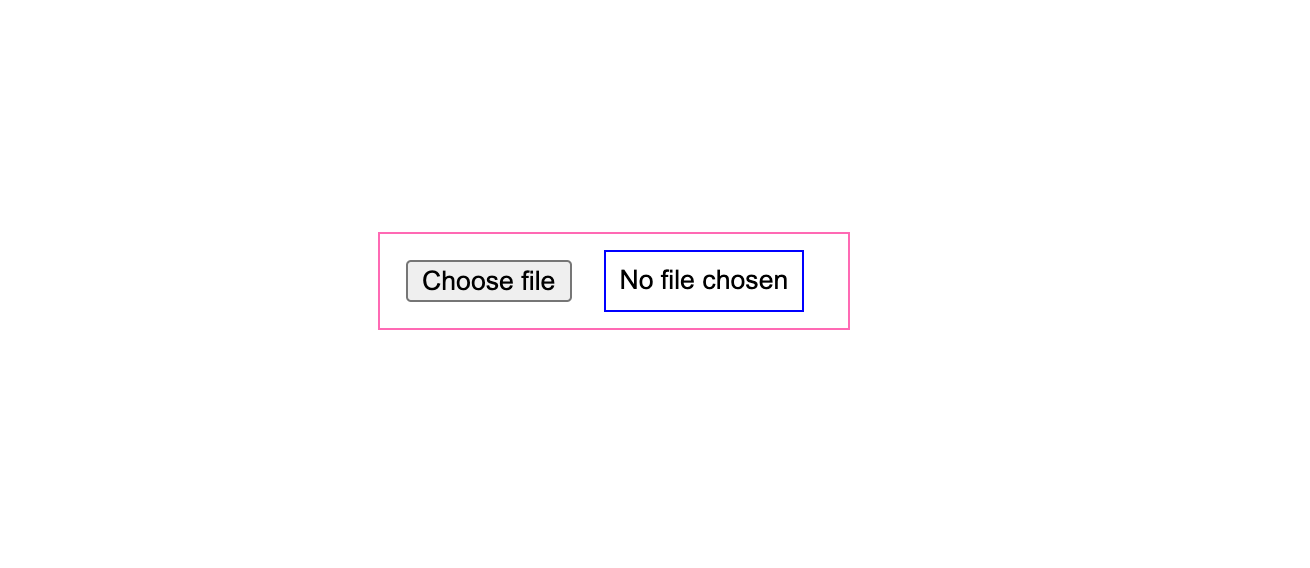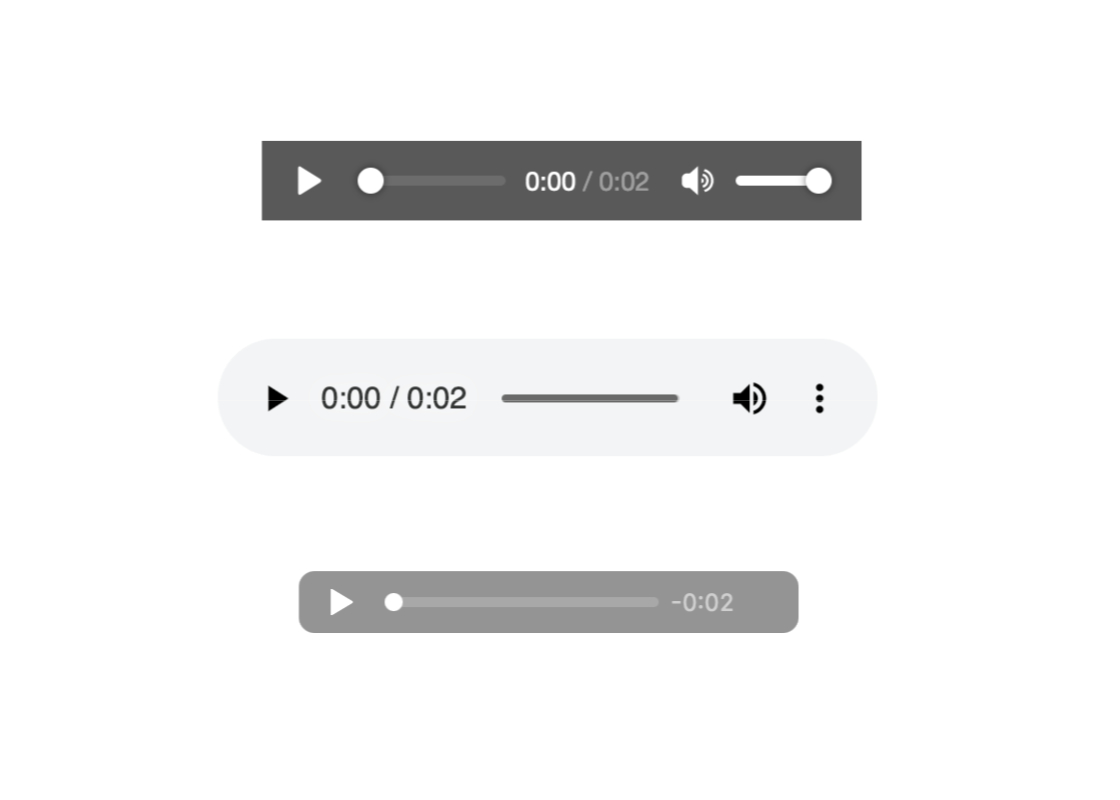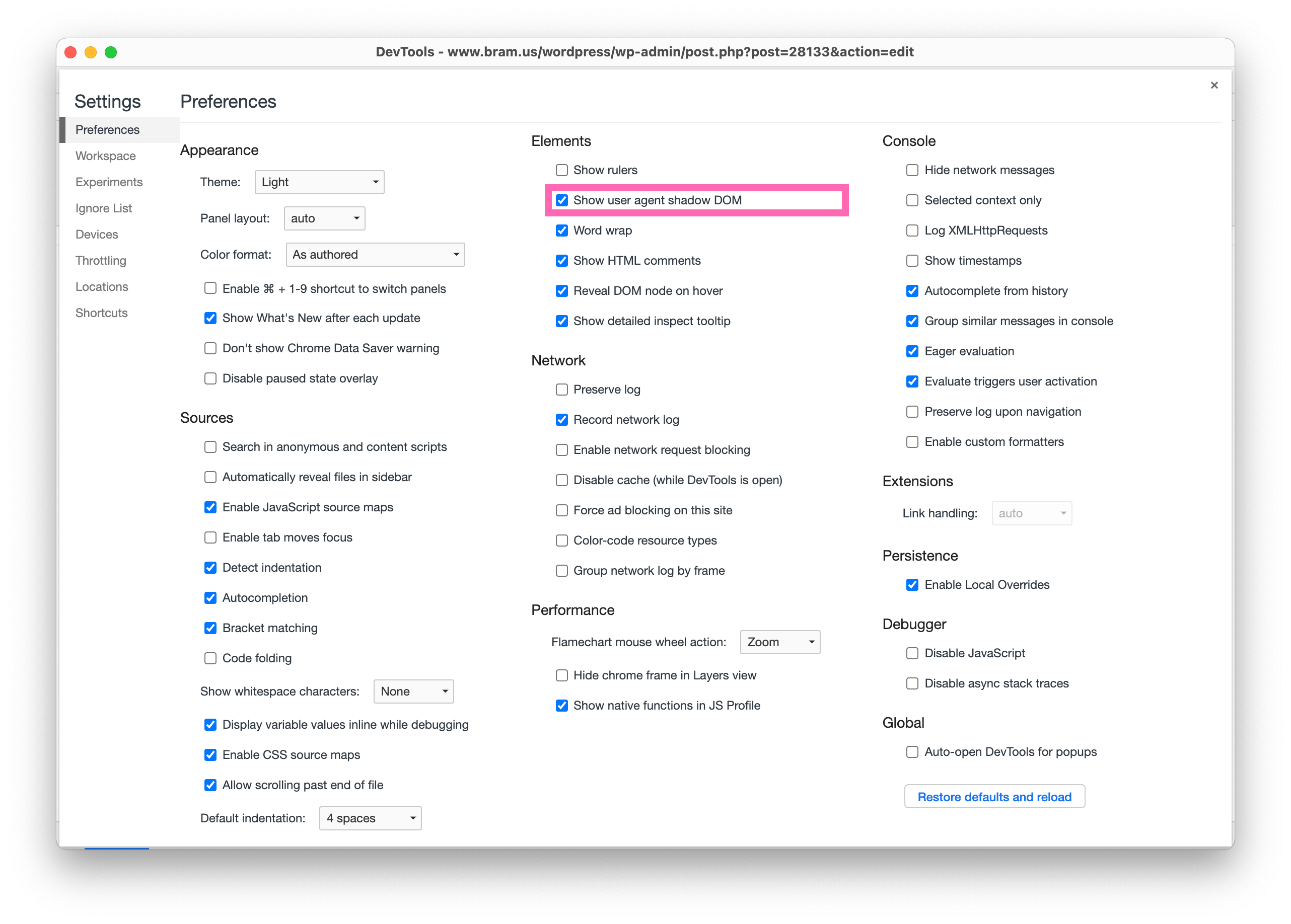Recently Stefan Judis shared how to style the browse button of a file selector using the ::file-selector-button pseudo-element
TIL – you can style the file input "browse" button using `::file-selector-button`.😲
— Stefan Judis (@stefanjudis) April 8, 2021
Supported in Firefox, Chromiums starting with 89 & Safari Tech preview.
🔗 MDN: https://t.co/56jACY9qK1
🔗 Compat data pr: https://t.co/vrFNS4LdIS
Video alt: Example of a styled browse button. pic.twitter.com/3YQ0njkX0J
But what about other complex elements in the browser? How can we tweak individual parts of those? Take <audio> for example: is there a pseudo-element we can use to style the play button?
~
Table of Contents
~
# Dissecting <input type="file" />
Before we answer the question above, let’s first take a look at the <input type="file" /> Stefan used. Below is screenshot of how it’s rendered in Chromium on Mac, with a few extra outlines added.

Even though we only type 1 element in our HTML code, we see it consists of two parts:
- A “Choose File” button
- A label reading “No file chosen”
Internally, this is also how the browser builds it. We type in:
<input type="file" />But what’s being rendered is this:
<input type="button" value="Choose file" pseudo="-webkit-file-upload-button" id="file-upload-button">
<span aria-hidden="true">No file chosen</span>(I’ll show you further down this post how I know this 😉)
The ::file-selector-button selector Stefan mentioned targets only the <input type="button" …> you see there. Using it you can style the button, like he did.
🧐 If you’re paying close attention you might notice that the pseudo-element used is ::file-selector-button, whilst the pseudo attribute of the button reads -webkit-file-upload-button. More on that further down the post 😉
~
# How to use DevTools to peek inside <input type="file" />
In the Chromium DevTools we don’t get to see the two elements that make up <input type="file" />. That’s because this information as is hidden in the Shadow DOM.
Thankfully there is a way to have DevTools show them. To do so, open DevTools’ Settings, and under Elements check the option that reads “Show user agent Shadow DOM”.
🦊 Firefox or 🧭 Safari user? The DevTools in Firefox/Safari have this option enabled out of the box.
Once enabled you’ll see #shadow-root (user-agent) appear in the Elements Tree for all elements that are built that way (and there quite a few!).
<input type="file">
↳ #shadow-root (user-agent)
<input type="button" value="Choose file" pseudo="-webkit-file-upload-button" id="file-upload-button">
<span aria-hidden="true">No file chosen</span>
</input>☝️ Having this option enabled all the time can be quite distracting. I personally only turn it on when I need it.
~
# Dissecting <audio>
Winging back to our initial question “is there a pseudo-element we can use to style the play button?”, we can use the DevTools to see the underlying structure.
In Chromium we get back this structure:
<audio controls="" src="/media/cc0-audio/t-rex-roar.mp3">
↳ #shadow-root (user-agent)
<div pseudo="-webkit-media-controls" class="phase-ready state-stopped">
<div pseudo="-webkit-media-controls-overlay-enclosure">
<input pseudo="-internal-media-controls-overlay-cast-button" type="button" aria-label="play on remote device" style="display: none;">
</div>
<div pseudo="-webkit-media-controls-enclosure">
<div pseudo="-webkit-media-controls-panel">
<input type="button" pseudo="-webkit-media-controls-play-button" aria-label="play" class="pause" style="">
<div aria-label="elapsed time: 0:00" pseudo="-webkit-media-controls-current-time-display" style="">0:00</div>
<div aria-label="total time: / 0:02" pseudo="-webkit-media-controls-time-remaining-display" style="">/ 0:02</div>
<input type="range" step="any" pseudo="-webkit-media-controls-timeline" max="2.115918" aria-label="audio time scrubber 0:00 / 0:02" aria-valuetext="elapsed time: 0:00">
<div pseudo="-webkit-media-controls-volume-control-container" class="closed" style="">
<div pseudo="-webkit-media-controls-volume-control-hover-background"></div>
<input type="range" step="any" max="1" aria-valuemax="100" aria-valuemin="0" aria-label="volume" pseudo="-webkit-media-controls-volume-slider" aria-valuenow="100" class="closed" style=""><input type="button" pseudo="-webkit-media-controls-mute-button" aria-label="mute" style="">
</div>
<input type="button" pseudo="-webkit-media-controls-fullscreen-button" aria-label="enter full screen" style="display: none;">
<input type="button" aria-label="show more media controls" title="more options" pseudo="-internal-media-controls-overflow-button" style="">
</div>
</div>
<div role="menu" aria-label="Options" pseudo="-internal-media-controls-text-track-list" style="display: none;"></div>
<div pseudo="-internal-media-controls-overflow-menu-list" role="menu" class="closed" style="display: none;">
<label pseudo="-internal-media-controls-overflow-menu-list-item" role="menuitem" tabindex="0" aria-label=" Play " style="display: none;">
<input type="button" pseudo="-webkit-media-controls-play-button" tabindex="-1" aria-label="play" class="pause" style="display: none;">
<div aria-hidden="true">
<span>Play</span>
</div>
</label>
<label pseudo="-internal-media-controls-overflow-menu-list-item" role="menuitem" tabindex="0" aria-label="enter full screen Full screen " style="display: none;">
<input type="button" pseudo="-webkit-media-controls-fullscreen-button" aria-label="enter full screen" tabindex="-1" style="display: none;">
<div aria-hidden="true">
<span>Full screen</span>
</div>
</label>
<label pseudo="-internal-media-controls-overflow-menu-list-item" role="menuitem" tabindex="0" aria-label="download media Download " class="animated-0" style="">
<input type="button" aria-label="download media" pseudo="-internal-media-controls-download-button" tabindex="-1" style="">
<div aria-hidden="true">
<span>Download</span>
</div>
</label>
<label pseudo="-internal-media-controls-overflow-menu-list-item" role="menuitem" tabindex="0" aria-label=" Mute " class="animated-2" style="display: none;">
<input type="button" pseudo="-webkit-media-controls-mute-button" tabindex="-1" aria-label="mute" style="display: none;">
<div aria-hidden="true">
<span>Mute</span>
</div>
</label>
<label pseudo="-internal-media-controls-overflow-menu-list-item" role="menuitem" tabindex="0" aria-label="play on remote device Cast " class="animated-1" style="display: none;">
<input pseudo="-internal-media-controls-cast-button" type="button" aria-label="play on remote device" tabindex="-1" style="display: none;">
<div aria-hidden="true">
<span>Cast</span>
</div>
</label>
<label pseudo="-internal-media-controls-overflow-menu-list-item" role="menuitem" tabindex="0" aria-label="show closed captions menu Captions " class="animated-0" style="display: none;">
<input aria-label="show closed captions menu" type="button" pseudo="-webkit-media-controls-toggle-closed-captions-button" tabindex="-1" style="display: none;">
<div aria-hidden="true">
<span>Captions</span>
</div>
</label>
</div>
</div>
</audio>Or visually, with outlines added:

With a bit of digging we can find the the play button on line #9, and extract its pseudo attribute.
<input type="button" pseudo="-webkit-media-controls-play-button" aria-label="play" class="pause" style="">👉 To style the play button we can use ::-webkit-media-controls-play-button
~
# Is there a catch?
While the ::-webkit-media-controls-play-button selector above works, there’s a catch though: it only works in Chromium based browsers, and this for several reasons:
-
Every browser engine has its own implementation for what makes up an
<audio>element. Shown below is a comparison of the UI for the<audio>as seen in Firefox, Chromium, and Safari.
Whilst all implementation contain a play button, not all — for example — contain an element that indicates the current time. Styling that wouldn’t be possible.
-
Not all browser expose the same parts of the UI using pseudo-elements. When it comes to
<audio>for example, only Chromium exposes parts of its UI. Firefox and Safari don’t expose any pseudo-element for<audio>And even if they would, the wouldn’t use
::-webkit-media-controls-play-buttonfor it.
Another aspect to take into account is that ::-webkit-media-controls-play-button is something that Chromium decided to use. This wasn’t discussed with any other browser vendor. As Thomas Steiner warns:
It’s like coding against a private API, though. The internals can change without prior notice. (In practice, things have been quite stable, but worth calling out.)
— Thomas Steiner (@tomayac) April 12, 2021
~
# One last thing
To close off I still owe you an explanation to why Chromium lists ::-webkit-file-upload-button for the browse button of <input type="file" />, instead of ::file-selector-button.
This is because they first exposed it using their own internal ::-webkit-file-upload-button name. It was only later that the CSS Working Group decided to standardize it to ::file-selector-button.
~
Thank me with a coffee.
I don\'t do this for profit but a small one-time donation would surely put a smile on my face. Thanks!
To stay in the loop you can follow @bramus or follow @bramusblog on Twitter.
